Why choose liquid argon for DUNE detectors?
In its quest to understand why matter exists, the flagship neutrino experiment hosted by Fermilab is constructing an enormous next-generation liquid-argon-based detector a mile underground. The Deep Underground Neutrino Experiment is building on the successes of previous liquid-argon experiments, promising measurements of unprecedented precision over a wide range of energies that will bring significant new insights into the nature of the universe.


